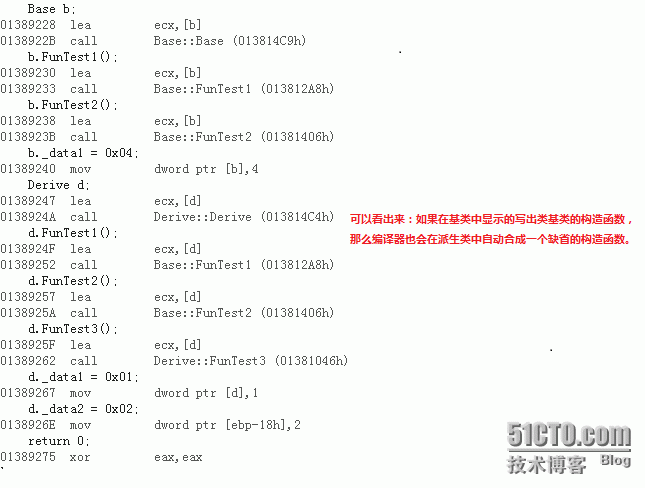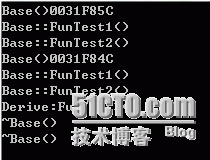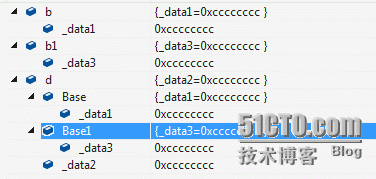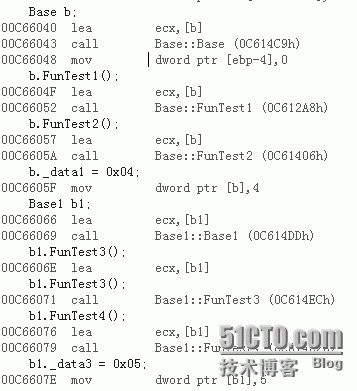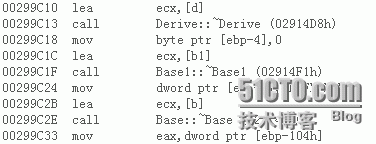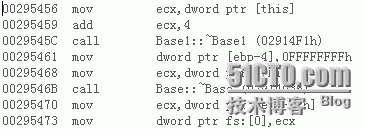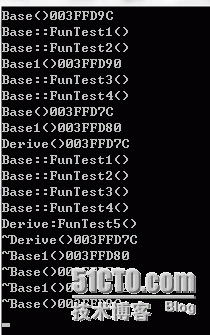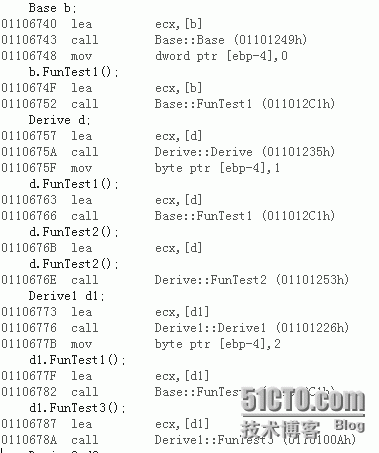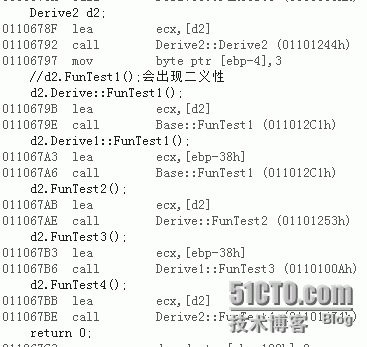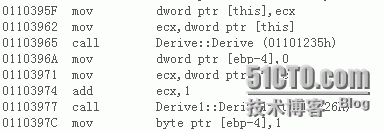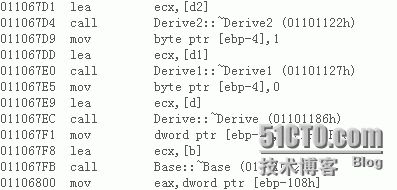繼承
1、單繼承
class Base
{
public:
Base()
{
cout << "Base()" << this << endl;
}
void FunTest1()
{
cout << "Base::FunTest1()" << endl;
}
void FunTest2()
{
cout << "Base::FunTest2()" << endl;
}
~Base()
{
cout << "~Base()" << endl;
}
int _data1;
};
class Derive :public Base
{
public:
void FunTest3()
{
cout << "Derive::FunTest3()" << endl;
}
int _data2;
};
int main()
{
Base b;
b.FunTest1();
b.FunTest2();
b._data1 = 0x04;
Derive d;
d.FunTest1();
d.FunTest2();
d.FunTest3();
d._data1 = 0x01;
d._data2 = 0x02;
return 0;
}——b對象和d對象的對象模型
main 函數的反彙編
派生類的構造函數:
程序運行結果:
構造函數:
基類構造函數:Base( )884 ->派生類構造函數: Base( )874 ->Derive( )874
析構函數:
派生類的析構函數:~Derive( )874 -> ~Base( )874->基類的析構函數:~Base( )884
2、多繼承
class Base
{
public:
Base()
{
cout << "Base()" << this << endl;
}
void FunTest1()
{
cout << "Base::FunTest1()" << endl;
}
void FunTest2()
{
cout << "Base::FunTest2()" << endl;
}
~Base()
{
cout << "~Base()" << endl;
}
int _data1;
};
class Base1
{
public:
Base1()
{
cout << "Base1()" << endl;
}
void FunTest3()
{
cout << "Base::FunTest3()" << endl;
}
void FunTest4()
{
cout << "Base::FunTest4()" << endl;
}
int _data3;
};
class Derive :public Base,public Base1
{
public:
Derive()
{
cout << "Derive()" << this << endl;
}
void FunTest5()
{
cout << "Derive:FunTest5()" << endl;
}
~Derive()
{
cout << "~Derive()" << endl;
}
int _data2;
};
int main()
{
Base b;
b.FunTest1();
b.FunTest2();
b._data1 = 0x04;
Base1 b1;
b1.FunTest3();
b1.FunTest4();
b1._data3 = 0x05;
Derive d;
d.FunTest1();
d.FunTest2();
d.FunTest3();
d.FunTest4();
d.FunTest5();
d._data1 = 0x01;
d._data2 = 0x02;
d._data3 = 0x03;
return 0;
}main函數的反彙編:
派生類的構造函數:
先調用Base的構造函數,再調用Base1的構造函數
析構函數的調用:
先是派生類的析構函數,再試Base1的析構函數,最後是Base的析構函數
在派生類的析構函數中又會調用基類的析構函數:
在派生類的析構函數中,也是先調用Base1的析構函數,再調用Base的析構函數。與構造函數的順序正好相反
程序運行的結果:
構造函數:
j基類的構造函數:Base( )D9c -> Base1( )D90 -> 派生類中的構造函數:Base( )D7c -> Base1 ( )D80 -> Derive( )D7c
析構函數:
派生類中的析構函數:~Derive( )D7c -> ~Base1( )D80 -> ~Base( )D7c ->基類的析構函數:~Base1( )D90 -> ~Base( )D9C
3、菱形繼承
class Base
{
public :
Base()
{
cout << "Base()" << this << endl;
}
void FunTest1()
{
cout << "Base::FunTest1()" << endl;
}
~Base()
{
cout << "~Base()" << endl;
}
};
class Derive : public Base
{
public :
Derive()
{
cout << "Derive()" << this << endl;
}
void FunTest2()
{
cout << "Derive:FunTest2()" << endl;
}
~Derive()
{
cout << "~Derive()" << endl;
}
};
class Derive1 : public Base
{
public :
Derive1()
{
cout << "Derive1()" << this << endl;
}
void FunTest3()
{
cout << "Derive:FunTest4()" << endl;
}
~Derive1()
{
cout << "~Derive1()" << endl;
}
};
class Derive2 : public Derive ,public Derive1
{
public :
Derive2()
{
cout << "Derive2()" << endl;
}
void FunTest4()
{
cout << "Derive:FunTest4()" << endl;
}
};
int main()
{
Base b;
b.FunTest1();
Derive d;
d.FunTest1();
d.FunTest2();
Derive1 d1;
d1.FunTest1();
d1.FunTest3();
Derive2 d2;
//d2.FunTest1();會出現二義性
d2. Derive ::FunTest1();
d2. Derive1 ::FunTest1();
d2.FunTest2();
d2.FunTest3();
d2.FunTest4();
return 0;
}對象模型:
Derive和Derive1中都含有了Base,會產生二義性和數據冗餘。
main函數的反彙編:
派生類的構造函數:
在派生類的構造函數中,都先調用的基類的構造函數。
Derive()
Derive1()
Derive2()
析構函數的調用:
析構函數的順序和構造函數的順序正好相反。
~Derive2( )->~Derive1( )->~Derive( )->~Base( ),
派生類中析構函數的調用:
在~Derive2(),先是自己的析構函數,再調用了~Derive1(),再調用了~Derive(),
在~Derive1( )中先是自己的析構函數,又調用了~Base()
在~Derive( )中先是自己的析構函數,又調用了~Base()
程序運行結果:
構造函數:
Base( )B8F ->
Derive的構造函數:Base( )B83 -> Derive( )B83->
Derive1的構造函數:Base( )B77 -> Derive1( )B77->
Derive2的構造函數:Base( )B6B -> Derive( )B6B ->Base( )B6C -> Derive1( )B6C ->Derive2( )B6B
析構函數:
~Derive2( )B6B -> ~Derive1( )B6C ->~Base( )B6C -> ~Derive( )B6B -> ~Base( )B6B
~Derive1( )B77 -> ~Base( )B77 -> ~Derive( )B83 -> ~Base( )B83
~Base( )B8F


